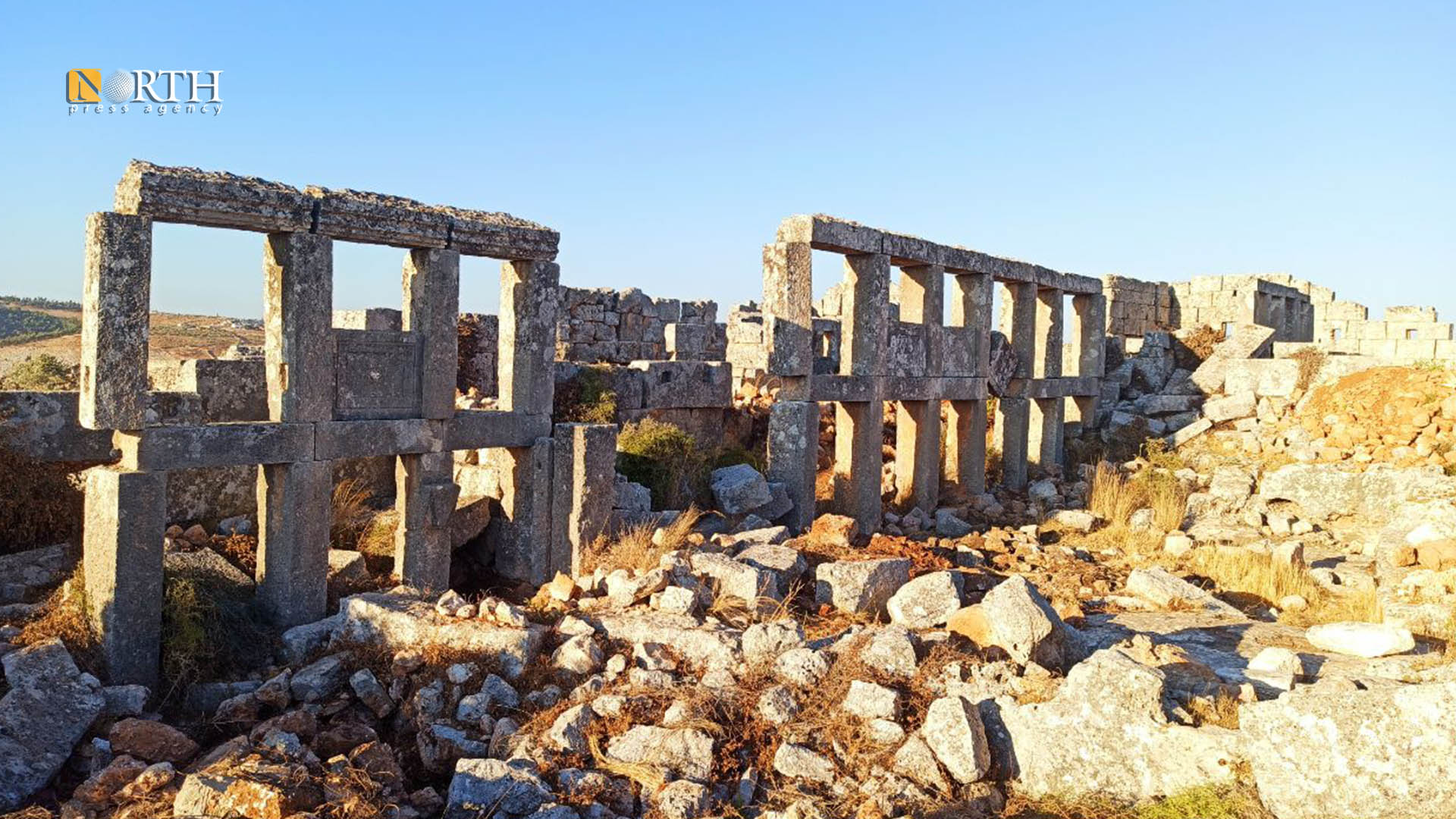IDLIB, Syria (North Press) – Over the past years, all the known archaeological sites in the Zawiya Mountain in Idlib countryside, northwest Syria, have been subjected to major excavations in which members of the Syrian Turkish-backed armed opposition factions and Hayat Tahrir al-Sham (HTS, formerly Jabhat al-Nusra) directly participated.
Among the most important archaeological villages in Zawiya Mountain are al-Bara, Sarjilla, Bshila, Majlila, Ba’oda, Batersa, Wadi Mertahon, Kawkaba, al-Maghara, La’lanta, Delouza, Deir Sunbul, Ain Larouz, Farkia, Belion, Shanshrah.
The archaeological site of al-Bara, which is now considered a front line with the government forces, is a model for indiscriminate and illegal excavations.
Members of the Turkish-backed factions are digging the place under the pretext that they are carrying out fortification work and combating trenches.
Nazih al-Homsi (pseudonym), a young man who searches for antiquities in Idlib, said that dozens of people in Idlib work in random excavations, most of them receive facilities from HTS.
“The excavation process is carried out with HTS knowledge, since they receive a percentage in the event of finding gold or valuable antiquities,” he added.
The Hague Convention for the Protection of Cultural Property (1954) in the Event of Armed Conflict adopted by the United Nations, sets rules for the protection of cultural goods during armed conflict.
However, organized groups looted museums and archaeological sites in Syria in order to illegally trade their rare pieces, according to what UNESCO has documented.
During a conference held in the Bulgarian capital to discuss ways to confront the looting of Syrian antiquities in September 2015, Irina Bokova, Director of the United Nations Educational, Scientific and Cultural Organization (UNESCO), said that satellites showed that archaeological sites in Syria are littered with thousands of illegal excavations.
HTS is everyone’s partner
“People affiliated with HTS and other people working in excavations, buy antiquities and smuggle them to Turkey to sell them for astronomical sums,” al-Homsi said.
“About three months ago, one of my friends found an archaeological tomb dating back to the Roman era in an archaeological site in the Zawiya Mountain area (the location was not mentioned). In it, he found approximately 150 kilograms of pure gold, in addition to small statues and ancient symbols,” he added.
He pointed out that he was surprised, hours later, that members of HTS raided his house, and they demanded a percentage of 40%, in addition to a fine of up to $50,000 on the pretext that he had not coordinated with them.
Al-Homsi stated that all or most of the people who work in excavations and traders who purchase antiquities, work with the permission of the HTS in return for a percentage.
Constant bombardment
Munir Qassas, one of the Idlib Museum staff, told North Press that the archaeological sites in Zawiya Mountain area were recently subjected to intense bombardment with dozens of rockets and artillery shells by government forces stationed at nearby checkpoints.
He added that this led to great damage and the destruction of some of them.
Zawiya Mountain includes important archaeological sites, some of which are still visible with their ruins and stone buildings, and others have disappeared, leaving only stone blocks remaining.
Qassas pointed out that most of the archaeological villages in Zawiya Mountain area were subjected to various damages, and it is not possible to determine the percentage of damage because it varies from one site to another, and sometimes within the same site.
So far, the sites of al-Bara, Serjilla, Shanshrah, Wadi Mertahoun, Delouza, Deir Sunbul and Ain Larouz have been subjected to shelling, due to their proximity to the front lines.
Illegal and indiscriminate excavations carried out by primitive methods and by people who are unfamiliar with archeology and excavation threaten the loss and demise of archaeological pieces and sites that testify to a rich history dating back thousands of years.
Antiquities’ dealers and brokers in Idlib deal with others in Turkey, and from there they are sold to museums and archaeologists in Europe.
In a previous report, one of the antiquities’ smugglers in Idlib said that foreign traders are complaining that some antiquities coming from Syria have been damaged due to using tools that are not suitable for excavation, which leads to the loss of their shapes and values.
Severe damage
Qassas stated that excavations have been going on for years, as many sites such as coffins and stone cemeteries were vandalized.
“Especially in the pyramidal cemetery in al-Bara area, in addition to the random digging and crushing of archaeological stones for use in building again,” he noted.
He indicated that those interested in antiquities, along with the Idlib Museum, have made attempts to establish an antiquities law that prohibits and criminalizes excavation, bulldozing and crushing operations, but this has not succeeded so far.
Qassas mentioned that it would be difficult to protect archaeological sites in Zawiya Mountain region, especially at the present time, until a ceasefire is reached, or through the intervention of international organizations interested in protecting antiquities such as UNESCO.
He added that emergency interventions can then be made to the buildings that were damaged by strengthening them and protecting them from falling.
But this requires huge efforts from the international community, international organizations interested in antiquities, local communities and workers in the field of antiquities, according to Qassas.

